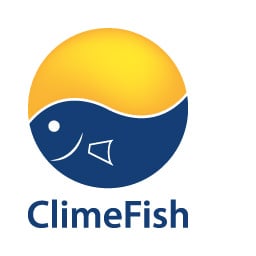ClimeFish has concluded, here is a short summary of results

This is a summary of results from the 4-year ClimeFish project funded by Horizon 2020 – the EU Research and Innovation programme
The overall goal of ClimeFish was to help ensure that the increase in seafood production comes in areas and for species where there is a potential for sustainable growth, given the expected developments in climate. ClimeFish thus contributed to establishing fisheries and aquaculture management plans that include climate adaptation measures, in co-creation with the operators and other stakeholders.
ClimeFish has:
- Investigated the effects of climate change on fisheries and aquaculture at European and regional scale, collected and harmonized relevant data, and identified knowledge gaps.
- Developed novel forecasting models to simulate and analyze changes in distribution and production in the fisheries and aquaculture sectors.
- Identified risks and opportunities based on analysis of market and non-market costs and benefits of affected ecosystem services and proposed potential mitigation strategies.
- Developed early warning methodologies for these risks, including a traffic-light system.
- In co-creation with stakeholders, developed case-specific Climate Adaptation Plans (CAPs) that mitigate risks and utilize opportunities associated with anticipated effects of climate change on aquatic production.
- In co-creation with stakeholders, developed guidelines, good practice recommendations and a voluntary European standard outlining how to develop CAPs.
- In co-creation with stakeholders, developed the ClimeFish Decision Support Framework (DSF). This contains the ClimeFish Decision Support System (DSS) and other decision support resources, such as models, datasets, sample runs and guidelines.
- Provided training and dissemination for industry, policy makers, scientists and other stakeholders.
Forecasting models:
The ClimeFish forecasting models are based on two IPCC climate scenarios (RCP 4.5 and RCP 8.5). ClimeFish focuses on three seafood production sectors: marine aquaculture, marine fisheries, and freshwater fisheries and aquaculture. These represent 15 case studies:
- Marine fisheries: the Baltic Sea (two cases), the North East Atlantic, the Barents Sea, West of Scotland, and the Adriatic Sea.
- Freshwater fisheries and aquaculture: North Norwegian lakes, Lake Garda in Italy, Czech Republic lakes, and pond production in Hungary.
- Marine aquaculture: the North East Atlantic, Greece, Spain, Scotland, and Italy.
The activities listed above have resulted in several key exploitable outcomes at case study level, and at European level and beyond.
Key exploitable outcomes at case study level:
- Forecasting models for seafood production that include increased temperature, and other climate change-related stressors, have been validated by stakeholders and fed into the risk assessments and CAPs
- Main identified knowledge gaps are lack of knowledge about the effect of combined stressors on fish and shellfish, and the lack of fine-scale local climate models, which is especially important for the aquaculture sector.
- Main identified risks for fisheries are reduction in stock biomass, change in distribution of target species, change in system productivity and emerging species.
- Main identified risks for aquaculture are pathogens, algae and jellyfish, feed price, increased predation, deterioration of infrastructure, changes in phenology, feed price or food availability, water quality. Extreme weather and storms challenge safety in all sectors.
- Main opportunities identified are increase in growth, aquaculture production, stock biomass and emerging species.
- Seven CAPs for fisheries and aquaculture are available and e.g. the Greek one is being implemented into a national adaptation plan.
- The ClimeFish DSF was launched at the 2020 International Forum on the Effects of Climate Change on Fisheries and Aquaculture.
Key exploitable outcomes at EU level and beyond:
- Contribution to the EU Adaptation Strategy Package by addressing each action in the EU Climate Adaptation Strategy and the strategy evaluation report.
- Guidelines for making CAPs for fisheries and aquaculture – a European voluntary standard (CWA) – is in place and is disseminated trough Climate-ADAPT, and the EU technical guidelines for multi annual plans for Aquaculture that are being revised.
- Guidelines for establishing legal good practice when resources move, have been developed together with the FishPoll game that allows stakeholders to elaborate on how to share a virtual moving stock.
- Recommendations for co-creation practices in transdisciplinary projects, and when developing CAPs and Decision Support for climate adaptation in the fisheries and aquaculture industry, are communicated to scientists, industry and policy makers.
- An e-learning course “Climate Change Adaptation and Mitigation in Fisheries and Aquaculture” on the FAO e-learning Academy
ClimeFish scientists and stakeholders now have the means to promote climate action for industry and policy makers. We have expanded the impact beyond Europe through cooperation with FAO, training in Vietnam and Chile, and the 2020 International Forum. Some of our exploitable outcomes have been implemented in Member States. We have shared experiences with our sister project CERES and other scientists and stakeholders across the world, and will further build on this network beyond the project lifetime. Our outcomes contribute to achieving several of the UN Sustainable Development Goals, especially SDGs 2, 3, 8, 9, 13, 14, 16 and 17.

